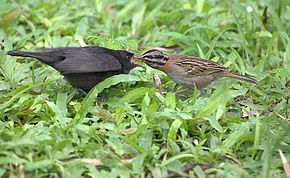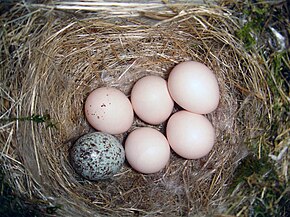

Brood parasitism is a subclass of parasitism and phenomenon and behavioural pattern of animals that rely on others to raise their young. The strategy appears among birds, insects and fish. The brood parasite manipulates a host, either of the same or of another species, to raise its young as if it were its own, usually using egg mimicry, with eggs that resemble the host's. The strategy involves a form of aggressive mimicry called Kirbyan mimicry.
The evolutionary strategy relieves the parasitic parents from the investment of rearing young. This benefit comes at the cost of provoking an evolutionary arms race between parasite and host as they coevolve: many hosts have developed strong defenses against brood parasitism, such as recognizing and ejecting parasitic eggs, or abandoning parasitized nests and starting over. It is less obvious why most hosts do care for parasite nestlings, given that for example cuckoo chicks differ markedly from host chicks in size and appearance. One explanation, the mafia hypothesis, proposes that parasitic adults retaliate by destroying host nests where rejection has occurred; there is experimental evidence to support this. Intraspecific brood parasitism also occurs, as in many duck species. Here there is no visible difference between host and parasite eggs, which may be why the parasite eggs are so readily accepted. In eider ducks, the first and second eggs in a nest are especially subject to predation, perhaps explaining why they are often laid in another eider nest.